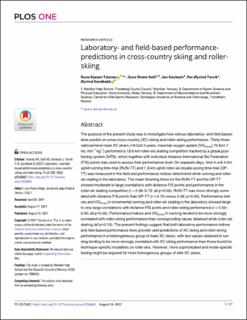| dc.contributor.author | Talsnes, Rune Kjøsen | |
| dc.contributor.author | Solli, Guro Strøm | |
| dc.contributor.author | Kocbach, Jan | |
| dc.contributor.author | Torvik, Per Øyvind | |
| dc.contributor.author | Sandbakk, Øyvind | |
| dc.date.accessioned | 2022-01-06T09:04:30Z | |
| dc.date.available | 2022-01-06T09:04:30Z | |
| dc.date.created | 2021-09-02T10:57:53Z | |
| dc.date.issued | 2021 | |
| dc.identifier.issn | 1932-6203 | |
| dc.identifier.uri | https://hdl.handle.net/11250/2836297 | |
| dc.description.abstract | The purpose of the present study was to investigate how various laboratory- and field-based tests predict on-snow cross-country (XC) skiing and roller-skiing performance. Thirty-three national-level male XC skiers (19.0±2.5 years, maximal oxygen uptake [VO2max] 70.8±4.7 mL·min-1·kg-1) performed a 13.6-km roller-ski skating competition tracked by a global positioning system (GPS), which together with individual distance International Ski Federation (FIS) points was used to assess their performance level. On separate days, time in a 6.4-km uphill running time-trial (RUN-TT) and 1.3-km uphill roller-ski double-poling time-trial (DP-TT) was measured in the field and performance indices determined while running and roller-ski skating in the laboratory. The mean finishing times for the RUN-TT and the DP-TT showed moderate to large correlations with distance FIS points and performance in the roller-ski skating competition (r = 0.56–0.72; all p<0.05). RUN-TT was more strongly correlated with distance FIS points than DP-TT (r = 0.72 versus 0.56; p<0.05). Performance indices and VO2max in incremental running and roller-ski skating in the laboratory showed large to very large correlations with distance FIS points and roller-skiing performance (r = 0.50–0.90; all p<0.05). Performance indices and VO2max in running tended to be more strongly correlated with roller-skiing performance than corresponding values obtained while roller-ski skating (all p<0.10). The present findings suggest that both laboratory performance indices and field-based performance tests provide valid predictions of XC skiing and roller-skiing performance in a heterogeneous group of male XC skiers, with test values obtained in running tending to be more strongly correlated with XC skiing performance than those found for technique-specific modalities on roller skis. However, more sophisticated and mode-specific testing might be required for more homogenous groups of elite XC skiers. | en_US |
| dc.language.iso | eng | en_US |
| dc.publisher | Public Library of Science | en_US |
| dc.rights | Navngivelse 4.0 Internasjonal | * |
| dc.rights.uri | http://creativecommons.org/licenses/by/4.0/deed.no | * |
| dc.title | Laboratory- and field-based performance-predictions in cross-country skiing and roller-skiing | en_US |
| dc.type | Peer reviewed | en_US |
| dc.type | Journal article | en_US |
| dc.description.version | publishedVersion | en_US |
| dc.source.journal | PLOS ONE | en_US |
| dc.identifier.doi | 10.1371/journal.pone.0256662 | |
| dc.identifier.cristin | 1930733 | |
| dc.relation.project | Norges forskningsråd: 298645 | en_US |
| dc.relation.project | Norges forskningsråd: 270791 | en_US |
| cristin.ispublished | true | |
| cristin.fulltext | original | |
| cristin.qualitycode | 1 | |

